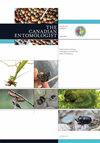Biology and Integrated Management of Wheat Stem Sawfly and the Need for Continuing Research
IF 1.1
4区 农林科学
Q3 ENTOMOLOGY
引用次数: 84
Abstract
Abstract The wheat stem sawfly, Cephus cinctus Norton (Hymenoptera: Cephidae), is historically one of the most important economic insect pests in the northern Great Plains of North America. Within this geographical region, the areas subjected to greatest attack are southern Alberta and Saskatchewan, southwestern Manitoba, eastern and northern Montana, North Dakota, northern South Dakota, and western Minnesota. Cumulative grain-yield losses and annual economic losses associated with this pest can exceed 30% and $350 million, respectively. Solid-stemmed cultivars of common wheat, Triticum aestivum L. (Poaceae), tolerant of infestation, are critical for C. cinctus management, but outbreaks of this pest continue to occur even after six decades of cultivar development. Furthermore, chemical control (a primary control option for other cereal (Poaceae) insect pests) has proven ineffective; this underscores the need to integrate resistant cultivars into a comprehensive integrated pest management program. We provide overviews of wheat stem sawfly biology, recent advances in applied research, the efficacy and integration of cultural and biological management strategies, and future directions for global research activities to manage wheat stem sawfly.小麦茎锯蝇的生物学、综合治理及继续研究的需要
摘要麦茎锯蝇(Cephus cintus Norton,膜翅目:蚜科)是北美大平原北部地区历史上最重要的经济害虫之一。在这个地理区域内,遭受最严重袭击的地区是阿尔伯塔省南部和萨斯喀彻温省,马尼托巴省西南部,蒙大拿州东部和北部,北达科他州,南达科他州北部和明尼苏达州西部。与这种害虫相关的累计粮食产量损失和年度经济损失可分别超过30%和3.5亿美元。抗虫害的普通小麦品种Triticum aestivum L.(禾科)是管理cinctus的关键品种,但即使经过60年的栽培发展,这种害虫的爆发仍在发生。此外,化学防治(对其他谷类(禾本科)害虫的主要防治选择)已被证明无效;这强调了将抗性品种纳入虫害综合治理计划的必要性。本文综述了小麦锯叶蝇的生物学、应用研究的最新进展、栽培和生物管理策略的有效性和整合,以及全球研究活动对小麦锯叶蝇管理的未来方向。
本文章由计算机程序翻译,如有差异,请以英文原文为准。
求助全文
约1分钟内获得全文
求助全文
来源期刊

Canadian Entomologist
生物-昆虫学
CiteScore
2.20
自引率
11.10%
发文量
24
审稿时长
6-12 weeks
期刊介绍:
French translation follows/le français suit Published since 1868, this peer-reviewed bimonthly publication is the official journal of the Entomological Society of Canada. Available via the internet and with hardcopy distribution to 55 countries, its research papers and notes are relevant to entomologists and other biologists around the world. In addition to being a venue for topical reviews and forum discussion, The Canadian Entomologist publishes current research in all facets of entomology, including systematics and morphology, molecular and developmental biology, ecology and behaviour, biodiversity and evolution, insect management, entomological techniques, and other relevant subject areas. Contributions are published in English or French. Authors will not pay page charges, and will experience fast, high quality reviews of their papers.Publiée depuis 1868, cette publication bimestrielle avec comité de lecture est la revue officielle de la Société d’entomologie du Canada. Disponible sur Internet et distribuée en format papier dans 55 pays, ses articles de recherche et ses notes sont pertinents pour les entomologistes et autres biologistes de par le monde. En plus d’être une plate-forme pour des revues thématiques et un forum de discussion, The Canadian Entomologist publie la recherche actuelle sur toutes les facettes de l’entomologie, incluant la systématique et la morphologie, la biologie moléculaire et développementale, l’écologie et le comportement, la biodiversité et l’évolution, la gestion des insectes, les techniques entomologiques et d’autres domaines pertinents. Les contributions sont publiées en français ou en anglais. Les auteurs ne paient aucun frais de publication, et recevront une révision rapide et de grande qualité de leurs articles.
 求助内容:
求助内容: 应助结果提醒方式:
应助结果提醒方式:


